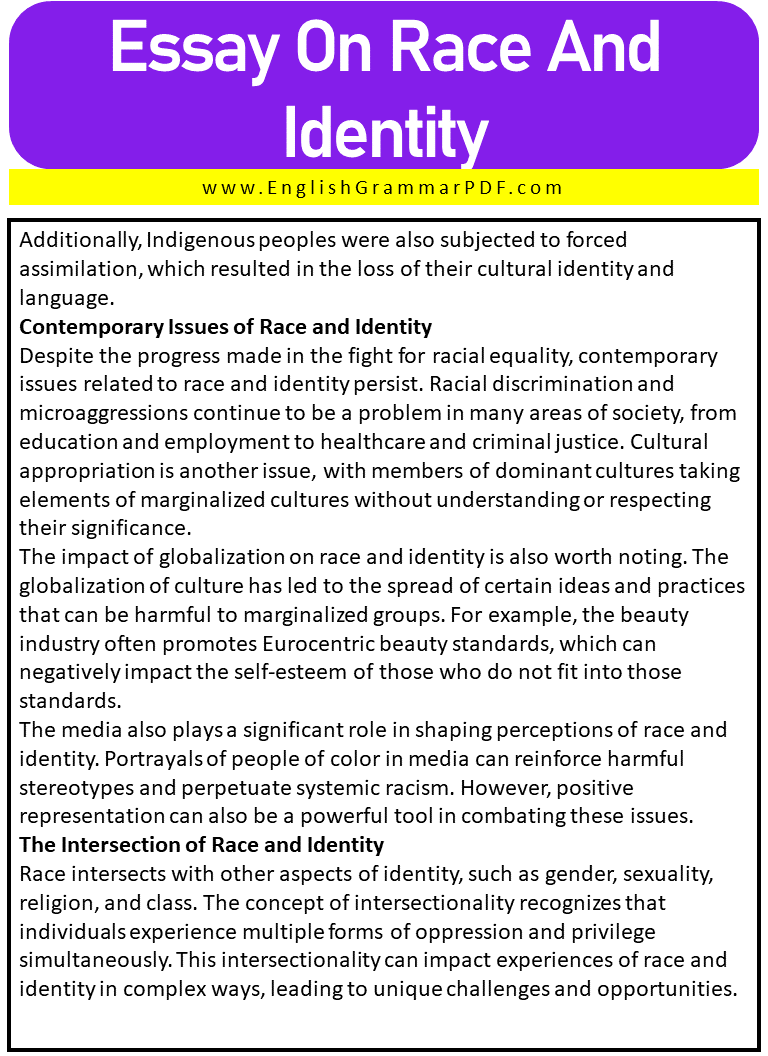Essay On Race And Identity
Outline of Essay:
- Introduction
- Historical Context of Race and Identity
- Contemporary Issues of Race and Identity
- The Intersection of Race and Identity
- The Complexity of Racial and Ethnic Identity
- The Importance of Representation in Race and Identity
Introduction
Race and identity are important aspects of the human experience. Our race and identity are not just about the color of our skin but also include our cultural background, beliefs, and experiences. How we identify ourselves and are identified by others can have a significant impact on our daily lives, from our interactions with others to our access to opportunities and resources.
Historical Context of Race and Identity
The construction of race and identity as social constructs has a long and complex history. The origins of modern racism can be traced back to the transatlantic slave trade, which created a hierarchy of power and oppression based on skin color.
During the colonial era, Europeans used scientific and pseudo-scientific ideas to justify their domination over other races. This led to the emergence of the idea of “scientific racism”, which claimed that certain races were biologically superior to others.
In the United States, racial categories were institutionalized through the “one-drop rule” which defined anyone with even a small amount of African ancestry as “Black”. This was used to justify segregation and discrimination against Black people. Additionally, Indigenous peoples were also subjected to forced assimilation, which resulted in the loss of their cultural identity and language.
Contemporary Issues of Race and Identity
Despite the progress made in the fight for racial equality, contemporary issues related to race and identity persist. Racial discrimination and microaggressions continue to be a problem in many areas of society, from education and employment to healthcare and criminal justice. Cultural appropriation is another issue, with members of dominant cultures taking elements of marginalized cultures without understanding or respecting their significance.
The impact of globalization on race and identity is also worth noting. The globalization of culture has led to the spread of certain ideas and practices that can be harmful to marginalized groups. For example, the beauty industry often promotes Eurocentric beauty standards, which can negatively impact the self-esteem of those who do not fit into those standards.
The media also plays a significant role in shaping perceptions of race and identity. Portrayals of people of color in media can reinforce harmful stereotypes and perpetuate systemic racism. However, positive representation can also be a powerful tool in combating these issues.
The Intersection of Race and Identity
Race intersects with other aspects of identity, such as gender, sexuality, religion, and class. The concept of intersectionality recognizes that individuals experience multiple forms of oppression and privilege simultaneously. This intersectionality can impact experiences of race and identity in complex ways, leading to unique challenges and opportunities.
The role of power and privilege is also important to consider in the intersection of race and identity. Those who hold power and privilege often benefit from systems that perpetuate inequality, while those who are marginalized face additional barriers to success and well-being.
The Complexity of Racial and Ethnic Identity
Racial and ethnic identity is complex and can be shaped by a variety of factors, including geography, culture, and family history. People from the same racial or ethnic group may have vastly different experiences and cultural practices based on their backgrounds. Additionally, cultural assimilation can impact how people identify with their racial or ethnic group.
The Importance of Representation in Race and Identity
One of the most significant benefits of representation is the validation it provides to people of color and other marginalized groups. When we see people who look like us, who share our experiences and struggles, it helps us feel seen and heard. Representation can also help to counteract harmful stereotypes and promote a more accurate understanding of different cultures and communities. For example, if all we see in the media are negative depictions of a particular group, it can lead to a biased and limited view of that community.
Representation can also help to increase empathy and understanding between different groups. When we see diverse stories and experiences, it can help to break down barriers and increase our capacity for empathy. This can be particularly important in increasingly diverse societies, as it can help to promote understanding and reduce prejudice.
However, representation is not just about visibility or promoting understanding. It is also about power and access. For example, when people from diverse backgrounds are not represented in positions of power, it can limit their ability to influence decisions that affect their lives. This can lead to policies that are biased or harmful to certain communities. Representation is therefore critical in ensuring that everyone has a voice and can participate fully in society.
FAQs
What is race and its identification?
Race is a social construct that categorizes people based on physical characteristics such as skin color, hair texture, and facial features. Identification of race is based on these physical characteristics and is often associated with cultural, historical, and political factors.
What is self-identified race and ethnicity?
Self-identified race and ethnicity refers to how an individual categorizes themselves based on their own cultural and ethnic background. It allows individuals to choose how they identify rather than being assigned a racial or ethnic category based on physical characteristics or ancestry.
Download the Pdf of the Essay On Race And Identity





Read More Essays:


